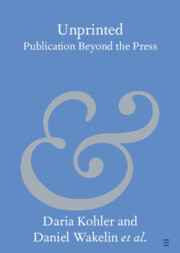Refine search
Actions for selected content:
63 results
Chapter 3 - Writing Up Research
- from Section 1 - Principles of Research
-
- Book:
- Research Methods in Mental Health
- Published online:
- 31 October 2025
- Print publication:
- 20 November 2025, pp 32-48
-
- Chapter
- Export citation
Intellectual Property in Developer-Funded Archaeology Projects in Britain from the Roman Period
-
- Journal:
- Britannia , First View
- Published online by Cambridge University Press:
- 07 November 2025, pp. 1-21
-
- Article
- Export citation
Chapter 27 - Publication
- from Part IV - Legacy
-
-
- Book:
- María Irene Fornés In Context
- Published online:
- 27 August 2025
- Print publication:
- 07 August 2025, pp 308-320
-
- Chapter
- Export citation
Chapter 35 - Seriality
- from Part VI - Critical Understandings
-
-
- Book:
- Sean O'Casey in Context
- Published online:
- 23 June 2025
- Print publication:
- 10 July 2025, pp 383-392
-
- Chapter
- Export citation
Chapter 15 - Comics Go to School
- from Part III - Emerging Media
-
-
- Book:
- Latinx Literature in Transition, 1992–2020
- Published online:
- 19 June 2025
- Print publication:
- 03 July 2025, pp 279-294
-
- Chapter
- Export citation
11 - Considering the effect of bias and confounding
- from Part 6 - Decision-making
-
- Book:
- Introduction to Epidemiology for the Health Sciences
- Published online:
- 28 May 2025
- Print publication:
- 24 April 2025, pp 316-347
-
- Chapter
- Export citation
7 - Achieving Transparency
- from Part II - Rethinking Research
-
- Book:
- Rethinking Clinical Research
- Published online:
- 13 March 2025
- Print publication:
- 20 March 2025, pp 137-159
-
- Chapter
- Export citation

Unprinted
- Publication Beyond the Press
-
- Published online:
- 15 January 2025
- Print publication:
- 30 January 2025
-
- Element
- Export citation
32 - What Do Journal Editors Look for in Publishing Conversation-Analytic Work?
- from Part VI - Situating and Reporting Findings
-
-
- Book:
- The Cambridge Handbook of Methods in Conversation Analysis
- Published online:
- 06 December 2024
- Print publication:
- 05 December 2024, pp 922-927
-
- Chapter
- Export citation
Updates to Article Categories for Prehospital and Disaster Medicine
-
- Journal:
- Prehospital and Disaster Medicine / Volume 39 / Issue 5 / October 2024
- Published online by Cambridge University Press:
- 27 December 2024, pp. 321-323
- Print publication:
- October 2024
-
- Article
-
- You have access
- Open access
- HTML
- Export citation
Chapter 22 - Academic Forensic Psychiatry
-
-
- Book:
- Seminars in Forensic Psychiatry
- Published online:
- 06 June 2024
- Print publication:
- 13 June 2024, pp 434-447
-
- Chapter
- Export citation
Chapter 5 - Fame and Famine
-
- Book:
- The Business of English Restoration Theatre, 1660–1700
- Published online:
- 18 October 2024
- Print publication:
- 13 June 2024, pp 166-213
-
- Chapter
-
- You have access
- Open access
- HTML
- Export citation
14 - Perspectives and Prospects
-
- Book:
- The Archaeology of Southern Africa
- Published online:
- 15 May 2024
- Print publication:
- 06 June 2024, pp 432-450
-
- Chapter
- Export citation
The BJPsych: your journal, your voice, your research, your choice
-
- Journal:
- The British Journal of Psychiatry / Volume 223 / Issue 5 / November 2023
- Published online by Cambridge University Press:
- 01 November 2023, pp. 499-500
- Print publication:
- November 2023
-
- Article
-
- You have access
- HTML
- Export citation
Local Worker and Excavation Director Relationships in Anatolia in the Mid-Twentieth and Early Twenty-First Centuries
-
- Journal:
- European Journal of Archaeology / Volume 27 / Issue 1 / February 2024
- Published online by Cambridge University Press:
- 02 October 2023, pp. 105-125
-
- Article
-
- You have access
- Open access
- HTML
- Export citation
Chapter 1 - Caroline Gonda in Conversation with Helena Whitbread
-
- Book:
- Decoding Anne Lister
- Published online:
- 29 June 2023
- Print publication:
- 13 July 2023, pp 18-26
-
- Chapter
-
- You have access
- Open access
- HTML
- Export citation
30 - Successfully Publishing Research in the Social and Behavioral Sciences
- from Part V - Tips for a Successful Research Career
-
-
- Book:
- The Cambridge Handbook of Research Methods and Statistics for the Social and Behavioral Sciences
- Published online:
- 25 May 2023
- Print publication:
- 08 June 2023, pp 651-670
-
- Chapter
- Export citation
19 - Registration and Publication
-
- Book:
- Aust's Modern Treaty Law and Practice
- Published online:
- 13 April 2023
- Print publication:
- 06 April 2023, pp 346-355
-
- Chapter
- Export citation
Chapter 26 - Molière and His Publishers
- from Part V - Reception and Dissemination
-
-
- Book:
- Molière in Context
- Published online:
- 10 November 2022
- Print publication:
- 24 November 2022, pp 246-255
-
- Chapter
- Export citation
3 - Coleridge and Collaboration
-
-
- Book:
- The New Cambridge Companion to Coleridge
- Published online:
- 13 November 2022
- Print publication:
- 24 November 2022, pp 30-45
-
- Chapter
- Export citation
